Chart 2.1 Composition of Australia’s Commonwealth and State and local taxes, 2012-13
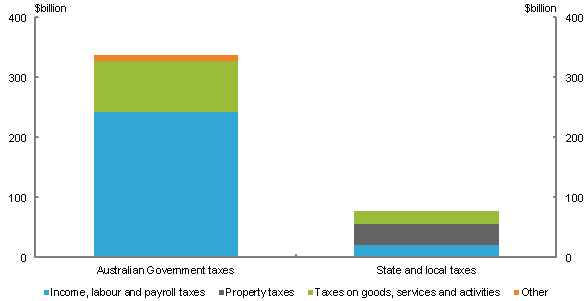
Note: Under the Australian System of Government Financial Statistics,6 royalty income is not a form of taxation and is included in the property income category along with interest income and dividends. Federal ‘Taxes on goods, services and activities’ includes the goods and services tax revenue.
Source: Australian Bureau of Statistics (ABS) 2014, Taxation Revenue, Australia, 2012-13, cat. no. 5506.0, ABS, Canberra.
This chart shows that Commonwealth tax revenue was over four times higher than state and local government tax revenue in 2012-13 (the latest year of data available). Commonwealth Government taxation was largely comprised from income taxes ($242 billion out of $338 billion). State and local government taxation was comprised of property taxes ($36 billion), payroll taxes ($21 billion) and taxes on goods, services and activities ($21 billion).
| Income, labour and payroll taxes ($billion) | Property taxes ($billion) | Taxes on goods, services and activities ($billion) | Other ($billion) | |
|---|---|---|---|---|
| Australian Government taxes | 242 | 0.01 | 86 | 10 |
| State and local taxes | 21 | 36 | 21 | 0 |
Chart 2.2 Total tax revenue as a percentage of GDP, OECD and selected Asian economies, 2012
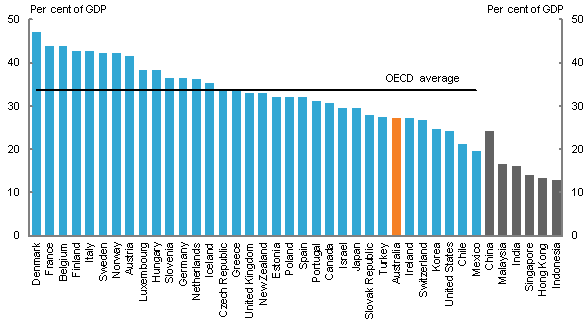
Note: Tax-to-GDP statistics for China, Hong Kong, Singapore and India have been prepared using the IMF’s Government Finance Statistics and are not directly comparable to OECD statistics. Unlike the OECD, the IMF does not classify social security contributions as a tax. To improve comparability with OECD statistics, tax-to-GDP ratios for China, Hong Kong, Singapore and India are calculated using IMF data but inclusive of social security contributions. Statistics for China are for 2011 and for India are for 2011-12.
Source: OECD 2014, Revenue Statistics 2014, OECD Publications, Paris; OECD 2014, Revenue Statistics in Asian Countries: Trends in Indonesia and Malaysia, OECD Publications, Paris; International Monetary Fund (IMF) 2014, Government Finance Statistics Yearbook, viewed 21 January 2015. IMF 2014, India Country Report No. 14/57, viewed 22 January 2015.
This chart shows total taxation (including social security contributions) as a ratio of GDP across the 34 OECD countries and six other Asian economies (China, Malaysia, India, Singapore, Hong Kong and Indonesia) in 2012. Of the OECD countries, Australia has the equal sixth lowest tax to GDP ratio (27.3 per cent). Mexico, Chile, United States, South Korea and Switzerland had lower tax to GDP ratios than Australia and Ireland had a similar tax to GDP ratio as Australia. The six non-OECD Asian economies listed had a lower tax to GDP ratio than Australia.
| Economy | Tax-to-GDP ratio |
|---|---|
| Denmark | 47.2 |
| France | 44.0 |
| Belgium | 44.0 |
| Finland | 42.8 |
| Italy | 42.7 |
| Sweden | 42.3 |
| Norway | 42.3 |
| Austria | 41.7 |
| Luxembourg | 38.5 |
| Hungary | 38.5 |
| Slovenia | 36.5 |
| Germany | 36.5 |
| Netherlands | 36.3 |
| Iceland | 35.3 |
| Czech Republic | 33.8 |
| Greece | 33.7 |
| United Kingdom | 33.0 |
| New Zealand | 33.0 |
| Estonia | 32.1 |
| Poland | 32.1 |
| Spain | 32.1 |
| Portugal | 31.2 |
| Canada | 30.7 |
| Israel | 29.6 |
| Japan | 29.5 |
| Slovak Republic | 28.1 |
| Turkey | 27.6 |
| Australia | 27.3 |
| Ireland | 27.3 |
| Switzerland | 26.9 |
| Korea | 24.8 |
| United States | 24.4 |
| Chile | 21.4 |
| Mexico | 19.6 |
| OECD average | 33.7 |
| China | 24.4 |
| Malaysia | 16.7 |
| India | 16.1 |
| Singapore | 14.1 |
| Hong Kong | 13.5 |
| Indonesia | 12.9 |
Chart 2.3 Taxes on corporate and personal income as a percentage of total taxation, OECD and selected Asian economies, 2012
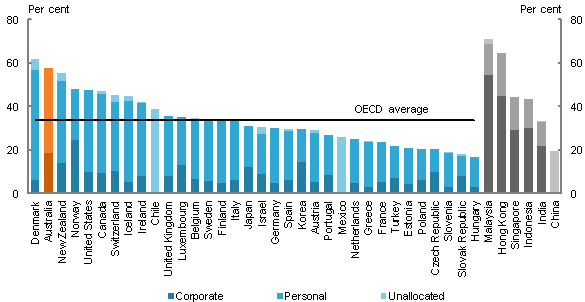
Note: Taxes on income are based on the OECD (series 1000) and IMF classifications (series 11). Estimates for China, Hong Kong and Singapore have been prepared using the IMF’s Government Finance Statistics, while estimates for India have been prepared using the CMIE database. These estimates are not directly comparable to OECD statistics. Unlike the OECD, the IMF does not classify social security contributions as a tax. To improve comparability with OECD statistics, total taxation estimates are prepared using IMF data but inclusive of social security contributions. Statistics for China are for 2011 and for India are for 2011-12.
Source: OECD 2014, Revenue Statistics 2014, OECD Publications, Paris; OECD 2014, Revenue Statistics in Asian Countries: Trends in Indonesia and Malaysia, OECD Publications, Paris; IMF 2014, Government Finance Statistics Yearbook, viewed 21 January 2014; IMF 2014, Government Finance Statistics, Mimas, University of Manchester, viewed 21 January 2015; Treasury calculations using CMIE 2014, viewed 23 January 2015.
This chart shows income taxation as a share of total taxation across 34 OECD countries and six other Asian economies (Malaysia, Hong Kong, Singapore, Indonesia, India and China) in 2012. Of the 34 OECD countries, income taxation as a share of total taxation is highest in Denmark and second highest in Australia. This chart also disaggregates income taxation into the taxes on corporate income, personal income and other (not able to be allocated between corporate and personal income) across these countries. Compared to the six non-OECD economies, Australia has higher income taxation as a share of total taxation than Singapore, Indonesia, India and China.
| Economy | Corporate tax | Personal tax | Unallocable or total taxes on income profit and capital gains |
|---|---|---|---|
| Denmark | 6.3 | 50.7 | 4.9 |
| Australia | 18.9 | 39.2 | 0.0 |
| New Zealand | 14.1 | 37.7 | 3.7 |
| Norway | 24.8 | 23.4 | 0.0 |
| United States | 10.2 | 37.7 | 0.0 |
| Canada | 9.5 | 36.6 | 1.1 |
| Switzerland | 10.5 | 31.7 | 3.4 |
| Iceland | 5.4 | 37.4 | 2.4 |
| Ireland | 8.4 | 33.2 | 0 |
| Chile | - | - | 39 |
| United Kingdom | 8.1 | 27.5 | 0 |
| Luxembourg | 13.4 | 21.9 | 0 |
| Belgium | 6.8 | 27.8 | 0 |
| Sweden | 6.1 | 28.2 | 0 |
| Finland | 4.9 | 29.3 | 0 |
| Italy | 6.5 | 27.2 | - |
| OECD average | - | - | 33.6 |
| Japan | 12.5 | 18.6 | 0 |
| Israel | 8.9 | 18.4 | 3.4 |
| Germany | 4.8 | 25.6 | 0 |
| Spain | 6.4 | 22.6 | 0.9 |
| Korea | 14.9 | 15 | 0 |
| Austria | 5.3 | 22.9 | 1.1 |
| Portugal | 8.7 | 18.5 | 0 |
| Mexico | - | - | 26.3 |
| Netherlands | 5.1 | 20.2 | 0 |
| Greece | 3.3 | 20.6 | 0.4 |
| France | 5.6 | 18 | 0 |
| Turkey | 7.4 | 14.4 | 0 |
| Estonia | 4.5 | 16.4 | 0 |
| Poland | 6.6 | 14.1 | 0 |
| Czech Republic | 9.9 | 10.6 | 0 |
| Slovenia | 3.4 | 15.5 | 0 |
| Slovak Republic | 8.4 | 9.2 | 0.8 |
| Hungary | 3.4 | 13.8 | 0 |
| Malaysia | 54.8 | 14.3 | 2 |
| Hong Kong | 45.1 | 19.7 | 0 |
| Singapore | 29.3 | 15.4 | 0 |
| Indonesia | 30.2 | 13.5 | 0 |
| India | 22 | 11.2 | 0.3 |
| China | - | - | 19.8 |
Chart 2.4 Direct taxes as a percentage of total taxation, OECD and selected Asian economies, 2012
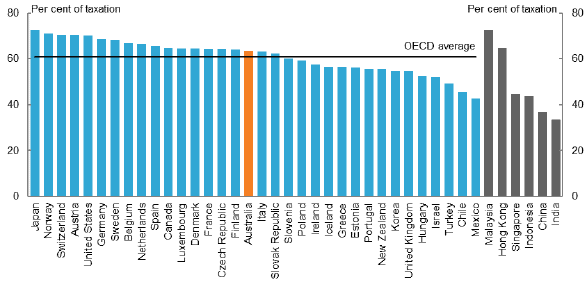
Note: Direct taxes include personal and corporate income taxes (OECD series 1000), social security contributions (OECD series 2000) and payroll and workforce taxes (OECD series 3000), but does not include other compulsory non-tax payments (such as the Superannuation Guarantee). Estimates for China, Hong Kong and Singapore have been prepared using the IMF’s Government Finance Statistics, while estimates for India have been prepared using the CMIE database. These estimates are not directly comparable to OECD statistics. Unlike the OECD, the IMF does not classify social security contributions as a tax. To improve comparability with OECD statistics, direct and total taxation estimates are prepared using IMF data but inclusive of social security contributions. Statistics for China are for 2011 and for India are for 2011-12.
Source: OECD 2014, Revenue Statistics 2014, OECD Publications, Paris; OECD 2014, Revenue Statistics in Asian Countries: Trends in Indonesia and Malaysia, OECD Publications, Paris; IMF 2014, Government Finance Statistics Yearbook, viewed 21 January 2014; IMF 2014, Government Finance Statistics, Mimas, University of Manchester, viewed 12 March 2015; Treasury calculations using CMIE 2014, viewed 23 January 2015.
This chart shows direct taxation as a share of total taxation across 34 OECD countries and six other Asian economies (Malaysia, Hong Kong, Singapore, Indonesia, India and China) in 2012. Direct forms of taxation – individuals and corporate income taxes, compulsory social security contributions plus payroll taxes – comprised around 63 per cent of taxation in Australia, compared to an OECD average of 61 per cent. Compared to the six non-OECD economies, Australia has higher direct taxation as a share of total taxation than China, India, Indonesia and Singapore.
| Economy | 2012 |
|---|---|
| Japan | 72.7 |
| Norway | 70.9 |
| Switzerland | 70.5 |
| Austria | 70.3 |
| United States | 70.2 |
| Germany | 68.7 |
| Sweden | 68.1 |
| Belgium | 66.8 |
| Netherlands | 66.4 |
| Spain | 65.7 |
| Canada | 64.8 |
| Luxembourg | 64.6 |
| Denmark | 64.4 |
| France | 64.3 |
| Czech Republic | 64.1 |
| Finland | 63.9 |
| Australia | 63.3 |
| Italy | 63.2 |
| Slovak Republic | 62.4 |
| OECD average | 61.0 |
| Slovenia | 59.9 |
| Poland | 59.2 |
| Ireland | 57.5 |
| Iceland | 56.4 |
| Greece | 56.3 |
| Estonia | 56.2 |
| Portugal | 55.5 |
| New Zealand | 55.5 |
| Korea | 54.8 |
| United Kingdom | 54.7 |
| Hungary | 52.4 |
| Israel | 51.8 |
| Turkey | 49.0 |
| Chile | 45.5 |
| Mexico | 42.8 |
| Malaysia | 72.6 |
| Hong Kong | 64.8 |
| Singapore | 44.7 |
| Indonesia | 43.8 |
| China | 36.7 |
| India | 33.5 |
Chart 2.5 Consumption taxes as a percentage of total taxation, OECD and selected Asian economies, 2012
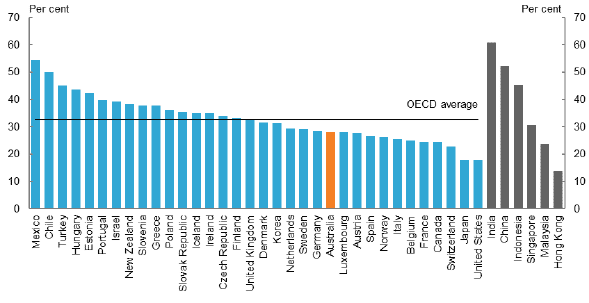
Note: Taxes on goods and services are based on the OECD (series 5000) and IMF classifications (series 14). Estimates for China, Hong Kong and Singapore have been prepared using the IMF’s Government Finance Statistics, while estimates for India have been prepared using the CMIE database. These estimates are not directly comparable to OECD statistics. Unlike the OECD, the IMF does not classify social security contributions as a tax. To improve comparability with OECD statistics, total taxation estimates are prepared using IMF data but inclusive of social security contributions. Statistics for China are for 2011 and for India are for 2011-12.
Source: OECD 2014, Revenue Statistics 2014, OECD Publications, Paris; OECD 2014, Revenue Statistics in Asian Countries: Trends in Indonesia and Malaysia, OECD Publications, Paris; IMF 2014, Government Finance Statistics Yearbook, viewed 21 January 2014; IMF 2014, Government Finance Statistics, Mimas, University of Manchester, viewed 21 January 2014; Treasury calculations using CMIE 2014, viewed 23 January 2015.
This chart shows consumption taxation as a share of total taxation across the 34 OECD countries and six other Asian economies in 2012. Consumption taxes comprised 28.1 per cent of total taxation in Australia, which was higher than ten OECD countries (such as the United States, Japan and Canada) and two non-OECD Asian economies (Malaysia and Hong Kong), but lower than the OECD average of 32.8 per cent.
| Economy | 2012 |
|---|---|
| Mexico | 54.5 |
| Chile | 50.1 |
| Turkey | 45.0 |
| Hungary | 43.7 |
| Estonia | 42.2 |
| Portugal | 39.7 |
| Israel | 39.2 |
| New Zealand | 38.3 |
| Slovenia | 37.9 |
| Greece | 37.8 |
| Poland | 36.2 |
| Slovak Republic | 35.4 |
| Iceland | 35.1 |
| Ireland | 34.9 |
| Czech Republic | 33.9 |
| Finland | 33.1 |
| United Kingdom | 32.9 |
| OECD average | 32.8 |
| Denmark | 31.4 |
| Korea | 31.2 |
| Netherlands | 29.3 |
| Sweden | 29.1 |
| Germany | 28.4 |
| Australia | 28.1 |
| Luxembourg | 28.1 |
| Austria | 27.6 |
| Spain | 26.6 |
| Norway | 26.3 |
| Italy | 25.5 |
| Belgium | 24.9 |
| France | 24.5 |
| Canada | 24.5 |
| Switzerland | 22.9 |
| Japan | 18.0 |
| United States | 17.9 |
| India | 60.9 |
| China | 52.1 |
| Indonesia | 45.4 |
| Singapore | 30.5 |
| Malaysia | 23.8 |
| Hong Kong | 13.8 |
Chart 2.6 Composition of Commonwealth taxes over time
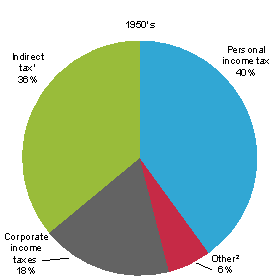



Note 1: On average in the 1950s, customs duties made up around 25 per cent of indirect tax compared with 10 per cent in 2013-14.
Note 2: For the 1950s, ‘Other’ includes payroll tax, land tax, estate duty, entertainments tax, gift duty and gold tax.
Source: Reserve Bank of Australia 1997, Australian Economic Statistics 1949-50 to 1994-95, Occasional Paper Number 8, viewed 10 December 2014; Australian Government 2014, Budget 2014-15 — online supplementary tables, Australian Government, Canberra, viewed 10 December 2014; and Australian Government 2014, 2013-14 Final Budget Outcome, Australian Government, Canberra; and Treasury estimates.
This chart shows the shares of Commonwealth taxes in the 1950s, 2000-01, 2013-14 and 2024-25. It is projected individuals tax will increase its share by 2024-25.
| 1950's | % |
|---|---|
| Personal income tax | 40% |
| Other | 6% |
| Corporate income taxes | 18% |
| Indirect tax | 36% |
| 2000-01 | % |
| Personal income tax | 47% |
| Corporate income taxes | 23% |
| Indirect tax (excl. GST) | 16% |
| GST | 14% |
| 2013-14 | % |
| Personal income tax | 50% |
| Corporate income taxes | 22% |
| Indirect tax (excl. GST) | 13% |
| GST | 15% |
| 2024-25 | % |
| Personal income tax | 56% |
| Corporate income taxes | 21% |
| Indirect tax (excl. GST) | 9% |
| GST | 14% |
Chart 2.7 Estimated cumulative increase in taxpayers in third and fourth tax brackets, relative to 2014-15
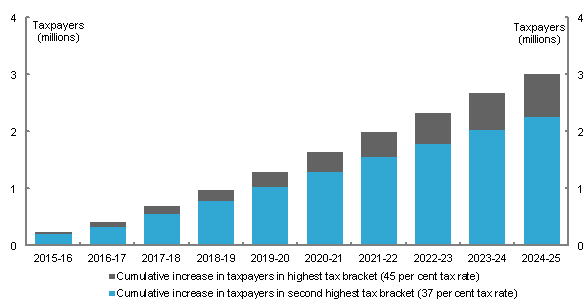
Note: Tax rates exclude Medicare Levy and Temporary Budget Repair Levy.
Source: Treasury estimates.
This chart shows the cumulative increase in the number of taxpayers in the highest and second highest tax brackets over the next 10 years, relative to 2014-15.
| 2015-16 | 2016-17 | 2017-18 | 2018-19 | 2019-20 | 2020-21 | 2021-22 | |
|---|---|---|---|---|---|---|---|
| Cumulative increase in taxpayers in highest tax bracket (45% tax rate) | 43,000 | 79,000 | 133,000 | 195,000 | 263,000 | 348,000 | 441,000 |
| Cumulative increase in taxpayers in second highest tax bracket (37% tax rate) | 202,000 | 338,000 | 562,000 | 792,000 | 1,028,000 | 1,296,000 | 1,553,000 |
| 2020-21 | 2021-22 | 2022-23 | 2023-24 | 2024-25 | |
|---|---|---|---|---|---|
| Cumulative increase in taxpayers in highest tax bracket (45% tax rate) | 348,000 | 441,000 | 535,000 | 639,000 | 751,000 |
| Cumulative increase in taxpayers in second highest tax bracket (37% tax rate) | 1,296,000 | 1,553,000 | 1,793,000 | 2,034,000 | 2,268,000 |
Chart 2.8 Personal income tax rates and the effects of bracket creep
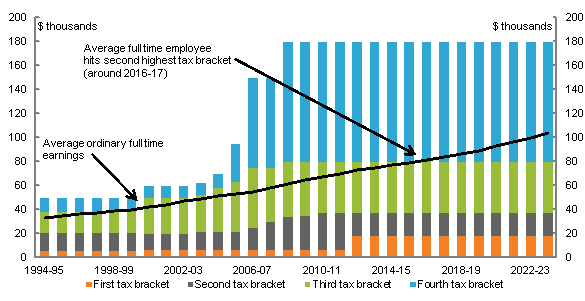
Source: Australian Bureau of Statistics (ABS) 2014, Average Weekly Earnings, Australia, May 2014, cat. no. 6302.0, ABS, Canberra and Treasury calculations.
This chart shows the historical and projected impact of bracket creep on taxpayers. The chart shows the individual income tax thresholds for each year from 1994-95 to 2023-24. The chart also shows the historical and expected change in average weekly ordinary time earnings over the same period. Put together, the chart shows that the people earning average weekly ordinary time earnings generally face the second marginal individual income tax rate. The exceptions to this historically were 1998-99 and 1999-00, when people earning average weekly ordinary time earnings (around $39,000 and $40,000 respectively) faced the third marginal individual income tax rate. Based on the current individuals’ income tax thresholds, people earning average weekly ordinary time earnings from 2016-17 are expected to have income upwards of $80,000 and face the third marginal individual income tax rate.
| Year | Average annual ordinary full-time earnings (from AWOTE) |
|---|---|
| 1994-95 | 33000 |
| 1995-96 | 35000 |
| 1996-97 | 36000 |
| 1997-98 | 37000 |
| 1998-99 | 39000 |
| 1999-2000 | 40000 |
| 2000-01 | 42000 |
| 2001-02 | 44000 |
| 2002-03 | 47000 |
| 2003-04 | 49000 |
| 2004-05 | 51000 |
| 2005-06 | 53000 |
| 2006-07 | 55000 |
| 2007-08 | 58000 |
| 2008-09 | 61000 |
| 2009-10 | 65000 |
| 2010-11 | 67000 |
| 2011-12 | 70000 |
| 2012-13 | 73000 |
| 2013-14 | 75000 |
| 2014-15 | 77000 |
| 2015-16 | 79000 |
| 2016-17 | 81000 |
| 2017-18 | 84000 |
| 2018-19 | 86000 |
| 2019-20 | 89000 |
| 2020-21 | 93000 |
| 2021-22 | 96000 |
| 2022-23 | 100000 |
| 2023-24 | 104000 |
| 1st threshold | 2nd threshold | 3rd threshold | 4th threshold | |
|---|---|---|---|---|
| 1994-95 | 5400 | 20700 | 38000 | 50000 |
| 1995-96 | 5400 | 20700 | 38000 | 50000 |
| 1996-97 | 5400 | 20700 | 38000 | 50000 |
| 1997-98 | 5400 | 20700 | 38000 | 50000 |
| 1998-99 | 5400 | 20700 | 38000 | 50000 |
| 1999-2000 | 5400 | 20700 | 38000 | 50000 |
| 2000-01 | 6000 | 20000 | 50000 | 60000 |
| 2001-02 | 6000 | 20000 | 50000 | 60000 |
| 2002-03 | 6000 | 20000 | 50000 | 60000 |
| 2003-04 | 6000 | 21600 | 52000 | 62500 |
| 2004-05 | 6000 | 21600 | 58000 | 70000 |
| 2005-06 | 6000 | 21600 | 63000 | 95000 |
| 2006-07 | 6000 | 25000 | 75000 | 150000 |
| 2007-08 | 6000 | 30000 | 75000 | 150000 |
| 2008-09 | 6000 | 34000 | 80000 | 180000 |
| 2009-10 | 6000 | 35000 | 80000 | 180000 |
| 2010-11 | 6000 | 37000 | 80000 | 180000 |
| 2011-12 | 6000 | 37000 | 80000 | 180000 |
| 2012-13 | 18200 | 37000 | 80000 | 180000 |
| 2013-14 | 18200 | 37000 | 80000 | 180000 |
| 2014-15 | 18200 | 37000 | 80000 | 180000 |
| 2015-16 | 18200 | 37000 | 80000 | 180000 |
| 2016-17 | 18200 | 37000 | 80000 | 180000 |
| 2017-18 | 18200 | 37000 | 80000 | 180000 |
| 2018-19 | 18200 | 37000 | 80000 | 180000 |
| 2019-20 | 18200 | 37000 | 80000 | 180000 |
| 2020-21 | 18200 | 37000 | 80000 | 180000 |
| 2021-22 | 18200 | 37000 | 80000 | 180000 |
| 2022-23 | 18200 | 37000 | 80000 | 180000 |
| 2023-24 | 18200 | 37000 | 80000 | 180000 |
Chart 2.9 Long-run modelling estimates of the marginal excess burden of some of Australia’s taxes
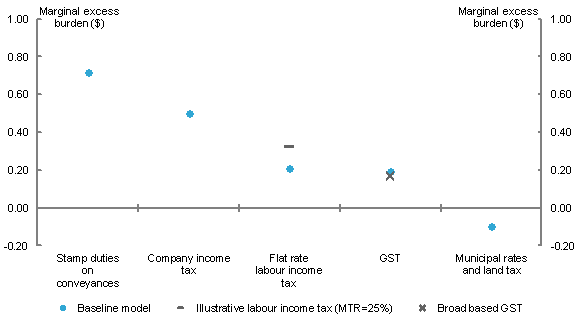
Note: Marginal excess burdens were estimated using a long-run CGE model of the Australian economy and tax system. Australian households are captured as a single economic unit in this model. The labour income tax is modelled as a stylised flat tax on labour income only. An out-of-model calculation for a marginal tax rate (MTR) of 25 per cent is presented as an illustration of an average taxpayer in 2011-12. Transfer payments are not captured in this model. For more information on this modelling, as well as analysis of a stylised capital component of individuals taxation, see the Australian Treasury working paper forthcoming, Understanding the economy-wide efficiency and incidence of major Australian taxes.
Source: Treasury estimates.
This chart plots the marginal excess burdens of stamp duties on conveyances, company income tax, flat rate labour income tax, goods and services tax, broad based goods and services tax and municipal rates and land tax, as well as an illustrative marginal excess burden for the progressive labour income tax.
| Baseline model | Broad based GST | Illustrative labour income tax (MTR=25%) | |
|---|---|---|---|
| Stamp duties on conveyances |
0.72 | ||
| Company income tax | 0.50 | ||
| Flat rate labour income tax | 0.21 | 0.32 | |
| GST | 0.19 | 0.17 | |
| Municipal rates and land tax | -0.10 |
Chart 2.10 Trends in corporate income tax rates, selected countries
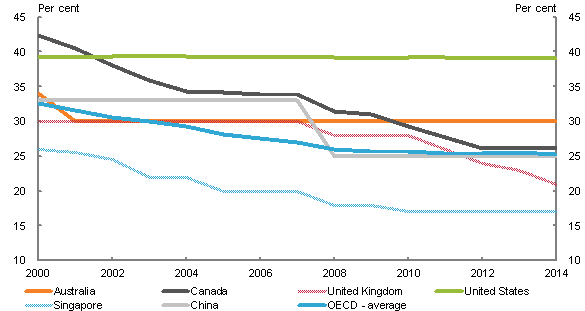
Source: OECD 2014, Tax Database — Taxation of Corporate and Capital Income, OECD, Paris, viewed 5 December 2014; KPMG 2014, Corporate tax rates table, viewed 5 December 2014; and KPMG 2007, Hong Kong Tax Competiveness Series: Corporate Tax Rates, viewed 5 December 2014; KPMG 2006, KPMG’s Corporate Tax Rate Survey, An international analysis of corporate tax rates from 1993 to 2006, viewed on 21 January 2015.
This chart shows the trend in corporate tax rates in Australia, Canada, Singapore, the United Kingdom, the United States of America, China and the OECD, from 2000-2014. It shows that the corporate tax rate in Australia and the United States has remained the same since 2001, while the corporate tax rate in the United Kingdom, Canada, Singapore, China and the OECD has fallen over this period.
| Country | 2000 | 2001 | 2002 | 2003 | 2004 | 2005 | 2006 |
|---|---|---|---|---|---|---|---|
| Australia | 34 | 30 | 30 | 30 | 30 | 30 | 30 |
| Singapore | 26 | 26 | 25 | 22 | 22 | 20 | 20 |
| Canada | 42 | 40 | 38 | 36 | 34 | 34 | 34 |
| China | 33 | 33 | 33 | 33 | 33 | 33 | 33 |
| United Kingdom | 30 | 30 | 30 | 30 | 30 | 30 | 30 |
| OECD - average | 33 | 32 | 31 | 30 | 29 | 28 | 28 |
| United States | 39 | 39 | 39 | 39 | 39 | 39 | 39 |
| Country | 2007 | 2008 | 2009 | 2010 | 2011 | 2012 | 2013 | 2014 |
|---|---|---|---|---|---|---|---|---|
| Australia | 30 | 30 | 30 | 30 | 30 | 30 | 30 | 30 |
| Singapore | 20 | 18 | 18 | 17 | 17 | 17 | 17 | 17 |
| Canada | 34 | 31 | 31 | 29 | 28 | 26 | 26 | 26 |
| China | 33 | 25 | 25 | 25 | 25 | 25 | 25 | 25 |
| United Kingdom | 30 | 28 | 28 | 28 | 26 | 24 | 23 | 21 |
| OECD - average | 27 | 26 | 26 | 26 | 25 | 25 | 25 | 25 |
| United States | 39 | 39 | 39 | 39 | 39 | 39 | 39 | 39 |
Chart 2.11 Transfer payments and taxes as a percentage of gross income by household income quintile, Australia, 2009-10
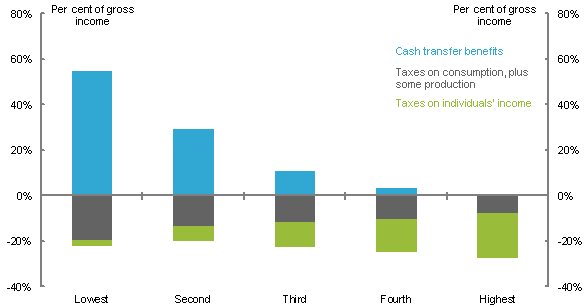
Note: Taxes on income include individuals income tax plus the Medicare levy and Medicare levy surcharge. Taxes on production include taxes payable on goods and services; taxes and duties on imports; and taxes on the ownership or use of land, buildings or other assets used in production or on labour (but not taxes on corporate profits or other business income). Transfer payments and taxes are expressed as a percentage of household gross income, which is before income tax and includes social assistance benefits received in cash. Household quintiles are defined according to equivalised disposable household income.
Source: Treasury calculations using ABS 2012, Government benefits, taxes and household income, Australia, 2009-10, cat. no. 6537.0, ABS, Canberra.
This chart shows transfer payments (received as cash), income taxes and production taxes as a proportion of gross household income by income quintiles for Australia in 2009-10. Taxes on income rise across the five household income quintiles, from around 0.4 per cent for the lowest income quintile to 20 per cent for the highest income quintile. In contrast, the taxes on production decline across the five household income quintiles, from 8 per cent for the highest income quintile to 19 per cent for the lowest income quintile. Transfer payments as a proportion of gross household income decline across the five income quintiles, from 59 per cent for the lower income quintile to 1 per cent for the highest income quintile.
| Lowest | Second | Third | Fourth | Highest | |
|---|---|---|---|---|---|
| Social assistance in cash benefits as per cent gross income | 54.8 | 29.5 | 11.2 | 3.3 | 0.6 |
| Taxes on production as percent of gross income | -19.4 | -13.3 | -11.6 | -10.2 | -7.5 |
| Taxes on income as percent of gross income | -2.5 | -6.4 | -10.8 | -14.5 | -20 |
Chart 2.12 Average tax wedge progression, OECD countries, 2013
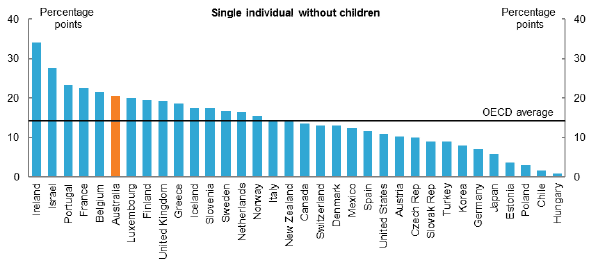
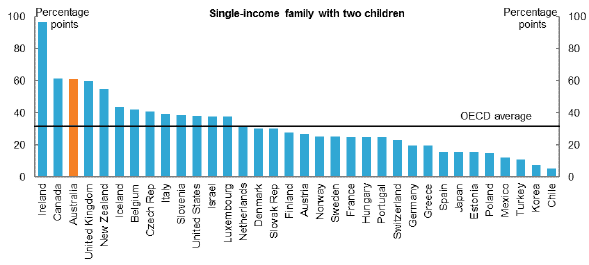
Note: The average tax wedge progression is the percentage point difference between the average tax wedge of an individual (or family) earning 250 per cent of average wages and the average tax wedge of an individual (or family) earning 50 per cent of average wages. The average tax wedge progression includes the effect of employee and employer social security contributions, payroll taxes and cash benefits.
Source: Treasury calculations using OECD 2014, Taxing Wages, OECD, Paris, viewed 3 December 2014.
There are two charts, each of which shows the change in the average tax wedge for 34 OECD countries as a household’s income increases from 50 per cent of average wages to 250 per cent of average wages for 2013. The first chart applies to the change in the tax wedge for a single person with no children, and shows that Australia has the sixth largest tax wedge progression. The second chart applies to the change in the tax wedge for a single-income family with two children, and shows that Australia has the third largest tax wedge progression.
| Country | Per cent |
|---|---|
| Ireland | 34.1 |
| Israel | 27.8 |
| Portugal | 23.3 |
| France | 22.5 |
| Belgium | 21.5 |
| Australia | 20.5 |
| Luxembourg | 20.1 |
| Finland | 19.6 |
| United Kingdom | 19.3 |
| Greece | 18.6 |
| Iceland | 17.4 |
| Slovenia | 17.4 |
| Sweden | 16.9 |
| Netherlands | 16.5 |
| Norway | 15.6 |
| Italy | 14.5 |
| New Zealand | 14.3 |
| OECD average | 14.2 |
| Canada | 13.5 |
| Switzerland | 13.2 |
| Denmark | 13.1 |
| Mexico | 12.4 |
| Spain | 11.6 |
| United States | 11.0 |
| Austria | 10.3 |
| Czech Rep | 9.9 |
| Slovak Rep | 9.0 |
| Turkey | 9.0 |
| Korea | 8.1 |
| Germany | 7.1 |
| Japan | 5.7 |
| Estonia | 3.7 |
| Poland | 2.9 |
| Chile | 1.6 |
| Hungary | 0.9 |
| Country | Per cent |
|---|---|
| Ireland | 96.7 |
| Canada | 61.5 |
| Australia | 60.9 |
| United Kingdom | 59.9 |
| New Zealand | 54.8 |
| Iceland | 43.8 |
| Belgium | 42.1 |
| Czech Rep | 40.9 |
| Italy | 39.2 |
| Slovenia | 38.6 |
| United States | 38.3 |
| Israel | 37.8 |
| Luxembourg | 37.7 |
| Netherlands | 32.1 |
| OECD average | 32.0 |
| Denmark | 30.1 |
| Slovak Rep | 30.1 |
| Finland | 27.7 |
| Austria | 27.0 |
| Norway | 25.4 |
| Sweden | 25.3 |
| France | 25.1 |
| Hungary | 24.9 |
| Portugal | 24.8 |
| Switzerland | 23.1 |
| Germany | 20.0 |
| Greece | 19.9 |
| Spain | 15.9 |
| Japan | 15.9 |
| Estonia | 15.9 |
| Poland | 15.1 |
| Mexico | 12.4 |
| Turkey | 10.9 |
| Korea | 7.4 |
| Chile | 5.5 |